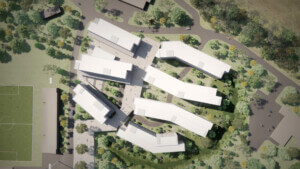Skidmore, Owings & Merrill (SOM) associate Neil Katz describes his approach to crafting facades as involving a “computational design” methodology.
In computational design, the architect generates solutions to a particular problem by first defining a set of rules and criteria for the model. Though the many tools Katz uses during this process include intangibles like “a desire to explore as many valid options as possible” and his office’s collaborative environment, in many instances he also performs literal computation—specifically, parametric modeling. Katz will moderate a panel on “Creating Complex Facades with Parametric Control” at next month’s Facades+ Chicago symposium. On day two of the conference, he and SOM colleague Joel Putnam will lead a dialog workshop on “New Techniques in Parametric Design.”
Parametric modeling can be the means to several ends, explained Katz. First, it can be used to explore a building’s massing, taking into account constraints like program, site, climate, context, and the overarching design concept. When applied to facade panelization, meanwhile, parametric control works with a different set of rules, including the relative flatness of the facade or the desire for regularity or other panel properties. Finally, observed Katz, “analysis and simulation, and visualization of the results, is also part of the parametric process—and can be a parametric process in its own right.”
Katz’s affinity for parametric design is in part an outgrowth of his interest in programming. “Even in school, but especially when I started working at SOM, this ability became a natural part of creating models, and performing many of the tasks I was given,” he said. During the 1980s, as a design student enrolled in computer science courses, he was an anomaly. But that may be changing. “For many years, engineers [also had to have] some expertise at programming to do their work,” said Katz. “That’s becoming true for architects as well. I would say that most architecture students are now interested in acquiring and using this skill.” He has observed a similar shift among his fellow architects at SOM. “More and more, my colleagues are building their own models, and my contribution is helping to develop a strategy to make the model as powerful and flexible as possible,” said Katz.
Like Katz, his co-panelists are working to solve some of the challenges inherent to parametric design, including the time it takes to perform the various analyses. Tristan d’Estrée Sterk, of Formsolver and ORAMBRA, is “currently developing a tool (Formsolver) which will allow architects to easily optimize a building’s form and material use as little energy as necessary,” said Katz. Matthew Shaxted will also join the conversation. Parallel.Works, the firm he co-founded, gives AEC industry professionals access to the computing power necessary to perform many of the analyses described above. “Parallel.Works does not create new tools, as Formsolver does, but allows people to use existing tools in a more powerful way,” observed Katz. Thornton Tomasetti vice president Hauke Jungjohann is the third member of the panel. A specialist in parametric modeling, form optimization, and digital information transfer, Jungjohann leads the Facade Engineering practice for the firm’s East U.S. Region.
Hear from Katz, d’Estrée Sterk, Shaxted, Jungjohann, and other leaders in the field of building envelope design and fabrication November 5-6 at Facades+ Chicago. Learn more and register today by visiting the Facades+ website.










